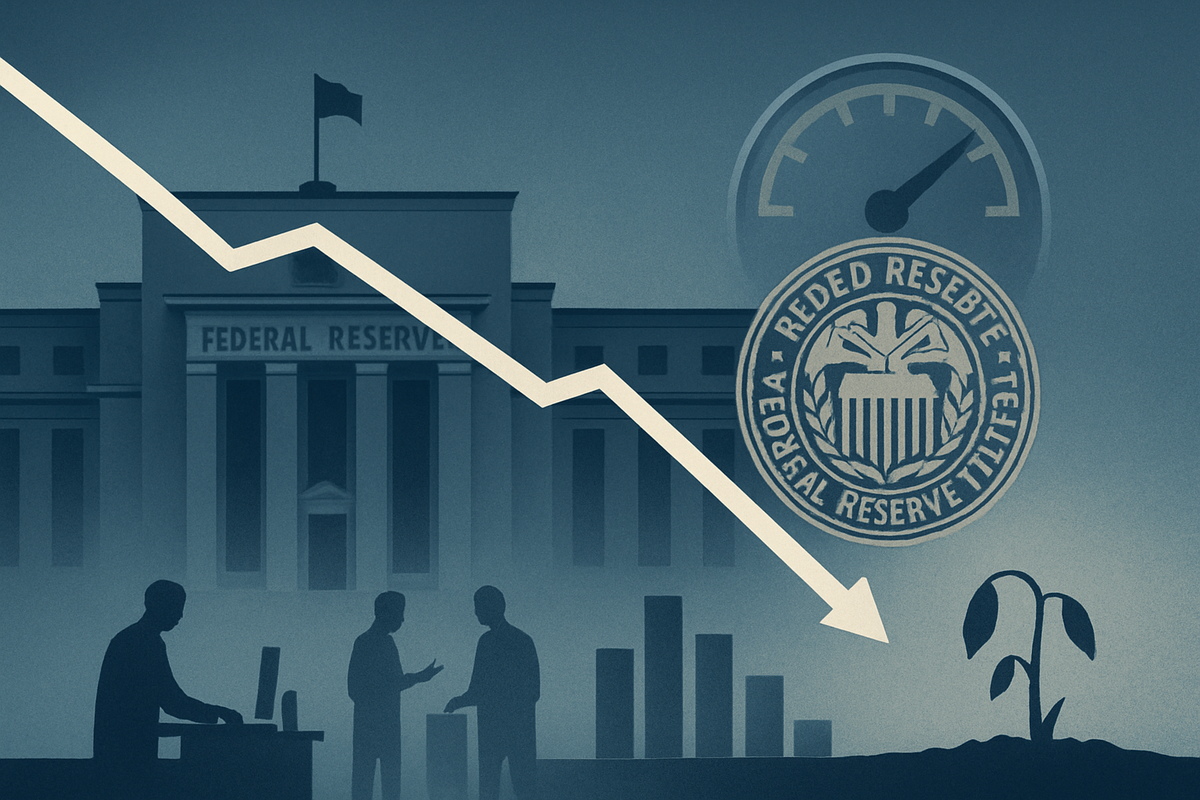
The Federal Reserve has announced a significant decision to cut its benchmark interest rate by 0.25 percentage points, bringing the federal funds rate target range down to between 3.75% and 4.00%. This move, the second such reduction in 2025, signals a proactive shift towards an easing monetary policy, primarily driven by growing concerns over a visibly weakening labor market. The immediate implications are far-reaching, promising a mixed bag for the broader economy and sending ripples through financial markets as investors digest the Fed's dovish stance.
This rate cut is a clear indication that the central bank is prioritizing employment stability over its ongoing battle against inflation, which, though "somewhat elevated," is currently taking a backseat to job market health. The aim is to stimulate economic activity by making borrowing cheaper for consumers and businesses, thereby encouraging investment, spending, and crucially, job creation to counteract the observed slowdown.
The Fed's Response to Faltering Employment
The Federal Reserve's recent 25-basis-point interest rate cut, announced close to October 30, 2025, was a direct response to a confluence of concerning labor market indicators. This marks the second rate reduction this year, highlighting the Fed's increasing apprehension about the economy's ability to sustain robust job growth. The decision was not made lightly, especially with inflation still lingering above the Fed's 2% target, reported at 3% in September. However, the prevailing sentiment within the Federal Open Market Committee (FOMC) appears to be that the risks associated with a faltering job market outweigh current inflation worries.
Key data points painted a grim picture of the labor landscape, compelling the Fed's hand. Non-farm payrolls saw a modest increase of only 22,000 in August, significantly missing expectations, and more alarmingly, private-sector payrolls reportedly shrank by 32,000 in September. The unemployment rate, while still relatively low, has begun to tick upwards, reaching 4.3% in August. Perhaps most concerning is the rise in long-term unemployment, with 1.9 million individuals unemployed for 27 weeks or longer in August 2025 – the highest share since February 2022. Furthermore, revisions by the Bureau of Labor Statistics revealed that nearly a million fewer jobs (911,000) were created than initially reported between April 2024 and March 2025, indicating a weaker foundation than previously understood. This backdrop of slowing job gains, increased layoffs from major corporations like (NASDAQ: AMZN) Amazon, (NYSE: TGT) Target, and (NASDAQ: PARA) Paramount, and a general reduction in hiring, fueled the Fed's intervention.
Initial market reactions were, as expected, a blend of relief and caution. The stock market generally responded positively, with the prospect of cheaper capital often seen as a boon for corporate earnings and growth sectors. However, volatility remains elevated as investors grapple with the underlying economic weakness that necessitated the cut. Bond markets saw prices for existing higher-yield bonds appreciate, with yields stabilizing or falling slightly. The U.S. dollar experienced some weakening, a typical consequence of rate cuts, which could make American exports more competitive. The Federal Reserve Chairman, Jerome Powell, emphasized the "data-dependent" nature of future monetary policy, adding a layer of uncertainty, especially given the lack of complete government economic data due to a recent shutdown, forcing reliance on private-sector indicators.
Navigating the Economic Currents: Winners and Losers
The Federal Reserve's decision to cut interest rates by 0.25 percentage points, driven by a weakening labor market, will undoubtedly create distinct winners and losers across various sectors and public companies. The primary goal of this easing is to stimulate borrowing and investment, but its effects will not be uniform.
Potential Winners:
- Housing and Real Estate: Lower interest rates typically translate to more affordable mortgages. This could invigorate the housing market, benefiting homebuilders like (NYSE: DHI) D.R. Horton and (NYSE: LEN) Lennar, as well as real estate investment trusts (REITs) like (NYSE: PLD) Prologis that finance commercial properties. Increased demand for housing could also boost home improvement retailers such as (NYSE: HD) Home Depot and (NYSE: LOW) Lowe's.
- Borrowers and Debt-Heavy Companies: Companies with significant variable-rate debt will see their interest expenses decrease, improving their bottom lines. This could include highly leveraged sectors such as utilities, certain industrial companies, and some mid-cap growth firms that rely on debt for expansion. Consumers with variable-rate credit cards and personal loans will also see slight relief.
- Growth Stocks: Technology and other growth-oriented companies, often valued on future earnings, tend to benefit from lower discount rates, which make their projected future cash flows more valuable today. Companies like (NASDAQ: MSFT) Microsoft and (NASDAQ: GOOGL) Alphabet, which often invest heavily in R&D and expansion, could find financing cheaper.
- Export-Oriented Companies: A weaker U.S. dollar, a common consequence of rate cuts, makes American goods and services cheaper for international buyers. This could boost the competitiveness and profitability of multinational corporations that derive a significant portion of their revenue from overseas, such as (NYSE: CAT) Caterpillar and (NYSE: KO) Coca-Cola.
Potential Losers:
- Banks and Financial Institutions: While lower rates can stimulate loan demand, they can also compress net interest margins (NIMs)—the difference between what banks earn on loans and pay on deposits. This can negatively impact profitability for major banks like (NYSE: JPM) JPMorgan Chase and (NYSE: BAC) Bank of America, especially if the yield curve flattens further.
- Savers and Fixed-Income Investors: Individuals relying on interest income from savings accounts, Certificates of Deposit (CDs), and money market funds will see their returns diminish. This could force them to seek riskier investments to achieve their financial goals.
- Insurance Companies: Insurers often invest premiums in conservative, fixed-income instruments. Lower interest rates can reduce their investment income, impacting profitability.
- Companies with Strong Dollar Exposure (Importers): While exporters benefit from a weaker dollar, companies that primarily import goods will find their costs increasing, potentially squeezing margins. Retailers heavily reliant on imported goods could face headwinds.
The impact will ultimately depend on the duration and depth of the labor market weakness and how effectively the rate cut stimulates broader economic activity without reigniting significant inflationary pressures. Investors will need to closely monitor company-specific fundamentals and their exposure to interest rate sensitivities.
Wider Significance and Historical Context
The Federal Reserve's latest interest rate cut, primarily in response to a weakening labor market, carries significant wider implications that extend beyond immediate market reactions. This move fits into a broader industry trend where central banks are increasingly navigating a delicate balance between managing inflation and fostering economic growth, especially in the face of global uncertainties and structural shifts in employment.
This easing cycle reflects a pivotal moment, potentially signaling a more prolonged period of accommodative monetary policy if labor market conditions continue to deteriorate. It suggests that the Fed is willing to tolerate inflation above its 2% target in the short term to prevent a more severe economic downturn and widespread job losses. Such a stance could lead to a 'lower for longer' interest rate environment, impacting everything from corporate investment strategies to pension fund returns. The ripple effects on competitors and partners are substantial. Companies that have been conservative with their borrowing may now find it more attractive to take on debt for expansion, potentially increasing competitive pressures in various sectors. Conversely, those already highly leveraged might find some breathing room, but their underlying business health remains paramount.
Regulatory and policy implications are also noteworthy. A sustained period of low rates could prompt discussions around financial stability, particularly concerning asset bubbles and excessive risk-taking. Policymakers might consider additional fiscal measures to complement monetary easing, especially if the labor market weakness persists. There could also be renewed scrutiny on the Fed's dual mandate, with questions arising about the effectiveness of monetary policy alone to address complex labor market issues.
Historically, the Fed has cut rates in response to labor market weakness during periods such as the dot-com bust in the early 2000s and the lead-up to the 2008 financial crisis. For example, during the early 2000s, persistent job losses prompted a series of rate cuts to stimulate the economy. A key difference in the current scenario is the lingering, albeit moderating, inflation, which was less of a concern in previous easing cycles driven by employment. This makes the current environment more complex, as the Fed is essentially choosing to fight one battle (unemployment) over another (inflation) in the short term. The comparison also highlights the Fed's commitment to avoiding a deep recession, even if it means deviating from its immediate inflation target.
What Comes Next: Navigating an Uncertain Economic Landscape
The Federal Reserve's recent interest rate cut, prompted by a softening labor market, ushers in a period of heightened anticipation and strategic recalibration for businesses and investors alike. In the short term, the immediate focus will be on the incoming economic data, particularly labor market reports and inflation figures, to gauge the efficacy of the Fed's move and inform potential future actions. Markets will be hypersensitive to any signals from the Fed regarding further rate cuts or a pause, with forward guidance becoming even more critical. Businesses, especially those in interest-rate-sensitive sectors like housing and automotive, may see a modest uptick in demand as borrowing costs ease.
Looking further ahead, the long-term possibilities depend heavily on whether this rate cut successfully stabilizes the labor market and reignites sustainable economic growth without triggering an uncontrollable surge in inflation. If successful, we could see a gradual recovery in employment and a return to more robust consumer spending and business investment. However, if the labor market continues to weaken despite the rate cut, or if inflation proves stickier than anticipated, the Fed might be forced into more aggressive easing or face a difficult dilemma, potentially leading to a stagflationary environment.
Potential strategic pivots or adaptations will be crucial for companies. Businesses with strong balance sheets might seize the opportunity of cheaper financing to invest in expansion, M&A, or technological upgrades. Those with significant debt will likely focus on refinancing to lock in lower rates. Companies in export-oriented industries should capitalize on a potentially weaker U.S. dollar, while importers may need to adjust their supply chains or pricing strategies.
Market opportunities may emerge in sectors poised to benefit from lower rates and increased economic activity, such as technology, consumer discretionary, and certain segments of industrials. Conversely, challenges could arise for financial institutions due to compressed net interest margins, and for conservative income investors seeing reduced returns on traditional savings. Potential scenarios range from a "soft landing" where the economy gradually recovers, to a "bumpy ride" with continued volatility, or even a "hard landing" if the labor market woes deepen into a recession, forcing the Fed's hand even further. Investors should prepare for continued data dependency and swift market reactions to economic news.
A Comprehensive Wrap-Up: Charting the Course Ahead
The Federal Reserve's decision to cut interest rates by 0.25 percentage points, driven predominantly by a weakening labor market, marks a significant juncture in the current economic cycle. The key takeaway is a central bank prioritizing employment stability and economic growth over immediate inflation control, signaling a more dovish stance than previously anticipated. This move aims to inject liquidity and reduce borrowing costs across the economy, hoping to spur investment and hiring. However, the backdrop of persistent, albeit moderating, inflation adds a layer of complexity, making this easing cycle distinct from historical precedents.
Moving forward, the market will remain highly sensitive to incoming economic data, particularly job reports, wage growth figures, and inflation metrics. Investors should assess their portfolios for interest rate sensitivity, favoring companies poised to benefit from cheaper capital or a weaker dollar, while exercising caution with those that might see squeezed margins or reduced returns on cash. The interplay between monetary policy and underlying economic fundamentals will dictate the market's trajectory.
The lasting impact of this rate cut will depend on its effectiveness in reversing the labor market's decline without reigniting inflationary pressures. If successful, it could pave the way for a more stable economic environment; if not, it could lead to further uncertainty and potentially more aggressive interventions. Investors should watch for the Fed's future guidance, any shifts in consumer and business confidence, and global economic developments that could influence the U.S. labor market. The coming months will be crucial in determining whether this preemptive strike by the Fed achieves its desired outcome.
This content is intended for informational purposes only and is not financial advice





